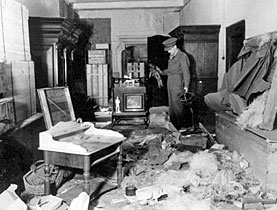Countries mull progress on Nazi looted art

Switzerland is among 49 nations meeting in the Czech Republic from Friday to discuss, among other issues, the thorny subject of art looted by the Nazis.
Thousands of works were plundered from Jewish families in the 1930s-40s and some have made their way to Switzerland. But finding the items and coming to an agreement over their fate is not always easy.
The five-day Holocaust Era Assets Conference in the capital, Prague, gathers together officials, non-governmental organisations and Jewish groups to discuss education and remembrance of the Holocaust, as well as property and stolen art issues.
Swiss delegation spokesman Benno Widmer told swissinfo.ch via email that the country attached great importance to the issues linked to the Shoah, or Holocaust. Switzerland has been a member of the International Task Force for International Cooperation in Holocaust Education, Remembrance and Research since 2004.
One of the main aims of the conference is to discuss progress made since the 1998 Washington Principles, in which 44 countries have agreed to identify stolen art, open up archives and achieve a “just and fair solution” with the original owners and their heirs.
Switzerland’s support for the principles showed that it attached great importance to the issue of looted art, Widmer said.
“The conference is an opportunity to reaffirm this support and Switzerland’s active role and to work on unresolved questions,” he added.
“Mass robbery”
According to the Jewish Claims Conference, the Nazis took an estimated 650,000 art and religious items from Jews and other victims. This has been described as “the greatest mass robbery” ever.
Works were handed over to top Nazi officials, auctioned off or stashed away.
Some ended up in Switzerland, and in 1947 a law was enacted to return this art to its rightful owners.
“By 1950, 77 looted paintings had been given back to French collectors and art dealers,” Andrea Raschèr, a legal expert in art, told swissinfo.ch.
The issue was forgotten during the Cold War, but resurfaced in the 1990s. A main turning point was an article by historian Thomas Buomberger, revealing that Swiss art dealers had been instrumental in the trafficking of stolen Nazi art.
This came at a time when revelations had surfaced about Swiss banks handling assets taken by the Nazis.
Swiss action
Raschèr, at that time head of legal and international affairs at the Federal Culture Office, commissioned a project to scan the government’s art collection for stolen items, as well as a report on the Swiss art market 1933-45 from Buomberger. This later became a well-known book.
In 1999 Raschèr set up the Contact Bureau for Looted Art to act as a “one-stop shop”, to help heirs negotiate with museums, foundations, cantons and cities, where much art in Switzerland is held.
Some cases have been settled quickly, such as when the Graubünden Fine Arts Museum returned a picture to the Silberberg family a decade ago.
But Raschèr believes the Bergier Commission, set up to investigate Switzerland’s Second World War asset dealings, did not make full use of its legal access to private or public archives and that this was a “missed chance” to gain a better view of the looted art scene.
He said that it was not possible to know how many stolen items are still in Switzerland. Many are thought to be in private collections. The Federal Culture Office has also recently started a survey of museums and their knowledge of paintings’ origins for an overview.
“Tip of the iceberg”
“I believe it’s the tip of the iceberg and that in the next decade looted art will surface,” Raschèr said. “It’s quite often a generation question, that when the heirs get the paintings they want to sell and the works then come on the market.”
It is important to find a “just and fair” solution for looted items, said Raschèr. Not all present owners knew the items’ provenance.
However, there is no Swiss specific law on looted art, such as in Germany or Austria, which has raised criticism from some experts.
Raschèr says conferences like Prague are important for sharing experiences and stepping up collaboration on issues like opening archives.
“It is now 70 years afterwards… We cannot undo what has been done, but we can acknowledge what has been done and show that we do not want the injustice of 70 years ago to be perpetuated,” he said.
Isobel Leybold-Johnson, swissinfo.ch
The Holocaust Era Assets Conference runs from June 26-30 in Prague in the Czech Republic. It is hosted by the Czech government, in conjunction with several culture and Jewish organisations. It is the closing event of the European Union Czech presidency.
The organisers hope that the conference will conclude with a declaration.
Around 500 delegates are taking part. The Swiss delegation is made up of members of the foreign and interior ministries, as well as experts in education and looted art.
The 1998 Washington Principles have been signed by Switzerland and 43 other nations. Under the voluntary agreement, countries have agreed to identify stolen art, open up archives, and achieve a “just and fair solution” with the original owners and their heirs.
According to Andrea Raschèr, just and fair solutions can range from restitution, payment for the work, selling and sharing the profits between original and present owner, to a museum showing a work with its cultural history clearly signposted.
There is a dispute in St Gallen about Swiss artist Ferdinand Hodler’s “Stockhorn chain with Lake Thun”, it was reported in the media this week.
In 1935 the Jewish businessman Max Silberberg was forced to sell most of his art collection, which is alleged to have included the Hodler.
The picture – bought in the 1980s when its provenance was unknown – now belongs to a foundation and is housed at the St Gallen Fine Arts Museum. It is being claimed by Silberberg’s daughter in law, Greta Silberberg. A decade ago, the Graubünden Fine Arts Museum returned a picture to her, which had been given as a gift to the museum in 1992.
Camille Pissarro’s Le Quai Malaquais et l’Institut has been removed from sale at Christie’s auction house in London over an ownership dispute, it has been reported. The picture, looted by the Gestapo, was previously stored in a Swiss bank vault.

In compliance with the JTI standards
More: SWI swissinfo.ch certified by the Journalism Trust Initiative











You can find an overview of ongoing debates with our journalists here . Please join us!
If you want to start a conversation about a topic raised in this article or want to report factual errors, email us at english@swissinfo.ch.